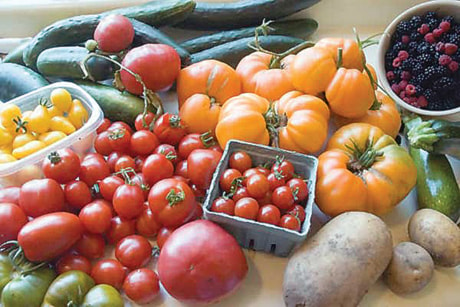HALIFAX — There’s more than pizza and dining hall food being eaten at a Halifax university this semester.
Two separate plots of land at Dalhousie University are producing everything from beet greens and brussels sprouts to heritage tomatoes to lavender and edible flowers. But one group of students found that getting permission to plant was as difficult as an organic chemistry exam.
“It took us a very long time to get this space, and this was not the space we wanted,” said Kaleigh McGregor-Bales of the group Campus Action on Food.
“This model of garden, since it’s in a container, can go on a concrete space, and what we wanted to do was take back unused concrete spaces on campus and use them for growth instead. However, the big, open concrete space next to the library that is completely underutilized was denied to us for this season.”
Sonia Grant, also with the group, said “the reason (given) was that it was too visible of a space.
“This was our compromise and it was quite a struggle to get this space, to get the university on board. It took about six months.”
The group’s Edible Campus space is on a small strip of land next to the back wall of the Student Union Building, where dozens of plastic containers are filled with swiss chard, beet greens, nasturtium, string beans, kale, tomatoes, peppers and radishes.
“We started everything from seed in April, and we started them in the Dal greenhouse, which is on the eighth floor of the Life Sciences Centre,” said Grant.
“Then we planted them in these containers on May 31, but they didn’t get to the campus until July 28. They were in my backyard.
“We’re going to be planting some more fall things. We’ve been harvesting since May, really, because we had a lot of salad greens like lettuce and arugula for the first months of summer, and now we’re on to crops that can tolerate different types of weather.”
Students who work on the garden share in the food, and Campus Action on Food has held a session to teach newbies how to use recycled materials to build the containers, which include a watering system built into a false bottom.
“We wanted a variety of crops that were easy to grow,” said McGregor-Bales. “This is our first season, so we basically wanted to test out different crops. We wanted food that students could learn from, something a little different, maybe, than they’re used to seeing, and crops that could grow in a shallow container in an urban setting.
“We see that there aren’t enough options on campus. The food on campus is very corporately controlled, is pretty inaccessible and not representative of students’ needs, so basically we’re looking to provide food by students, for students in a way that’s accessible and affordable and ethical.”
A couple of blocks away from the Student Union Building is the SeeMore Green collective garden, which has been in existence since 1996, although not always in this space. Signs on a shed include instructions like “Please do not harvest any more brussels sprouts until they get a bit bigger.”
“You don’t need a lot of space to have a high yield,” said co-ordinator Megan Tardif-Woolgar. “We don’t produce a whole lot on account of the shade. They stuck us into this area and we don’t get a whole lot of sun or just dappled sun.”
The SeeMore Green garden consists mostly of raised beds and this year is heavy on brussels sprouts and red cabbage, although there is an experiment to see how successfully corn can be grown in a bucket, and a herb garden growing oregano, as well as lavender, tarragon and thyme.
“We’re not so much a community garden in the sense that everyone gets their own plot; we just don’t have the space for that,” said Tardif-Woolgar. “We’re more of a collective, where everyone can come and share skills and learn from each other and participate in workshops, anything from how to build your own compost to (Tuesday) night’s plant propagation workshop.
“We made seed bombs one day; it’s a guerrilla gardening tactic. You take a bit of clay and put some compost in it, add some seeds to it. You can squish it up into a ball and throw it wherever you want to and it’s its own self-contained garden, so you can throw it over fences.”
